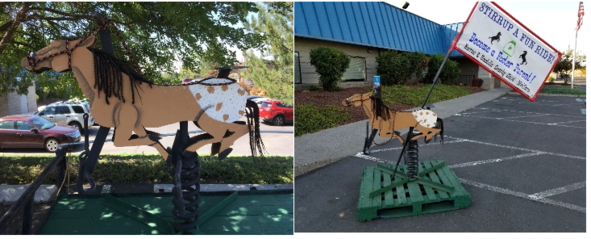|
Welcome to the first electronic caregiver quarterly newsletter!
One of the suggestions that has been heard loud and clear from current and former foster parents was the need for better communication between caregivers and the Oregon Department of Human Services. Our hope is that this newsletter provides you with increased communication about new initiatives, changes that impact you as caregivers, training, resources and positive stories occurring around your community. You can expect the next edition to come to your email boxes in January 2019. CHAT News can also be found online, on our Newsletters, Articles & Insight page by subscribing to this newsletter. If there are topics or areas you would like to see in future edditions, please contact us:FosterFamily.Supports@dhsoha.state.or.us.We hope you enjoy this new way to keep informed about some of the things that are happening in Child Welfare.
|
In this issue you will find:
- Director's message
- Employee spotlight
- Program information
- Community spotlight
- Training opportunity
|
|
 |
Director’s message
I have experienced the Child Welfare System from many perspectives. I know firsthand what our families and staff experience and I know that caring for Oregon’s children can be overwhelming. It is a task that requires Child Welfare, the greater community and families, all working together to achieve solutions.
As we move forward, I need your help in making real change. Our vision is for every child and family to have a safe and positive environment in which to live and develop. Below are some of the principles that you can model and help us collectively achieve that vision.
-
Safety first mindset – every effort is made to keep children and families together without compromising safety
-
Smaller, more efficient and effective system –helping to address individualized needs while staying no longer than necessary
-
Addressing ethnic and racial disparities – reducing overrepresentation of minority populations
-
Optimized resources – keeping appropriate number of staff, foster parents and providers that have training, resources and support to keep children healthy and safe
-
Data-informed, evidence based and outcome driven – using predictive analytics and data to inform/support decisions and to measure outcomes and results
-
Community and system engagement – leveraging the wisdom, resources and support from our communities and partners
-
Building a new culture – fostering a caring and supportive environment
-
Honoring the Tribes – higher level of engagement around training and implementation of the Indian Child Welfare Act (ICWA)
I know the work you do every day is not easy. You give your hearts to ensure every child has a safe and positive environment in which to live and develop. And for that I thank you! Together we can improve outcomes for our children and families.
With appreciation,
Marilyn
Employee spotlight
Meet Jana Mclellan
 |
|
Hired on Tax Day of 2013 (4/15/13), Jana became the Director of the State Operated Community Programs (SOCP), which is part of the Office of Developmental Disabilities Services. She was tasked with transforming the organization consisting of more than twenty residential group homes into a short-term Stabilization and Crisis Unit (SACU). Today you will find her sitting next to Marilyn Jones as the Deputy Director for Child Welfare. |
Jana’s decision to leap into the Deputy Director role was solely based on the opportunity to be a part of the effort to continue the transformation of an organization which supports children and families served by DHS. “My hopes for my role are to offer senior leadership support that allows for increased bandwidth, to continue to stretch my own learning for those I work with and to really make a difference for the children and families supported by Child Welfare.”
During Jana’s last five years at SACU, her greatest accomplishment and privilege has been the ability to create and support a great team of managers. “We created a program all can be proud of, aligned with DHS values and mission, created a person-centered model of service, and, I believe, built a sustainable and defendable program that serves some of the most vulnerable folks in the state. I look forward to saying the same things about my next five years with Child Welfare.”
Program Information
The Independent Living Program (ILP)
The Independent Living Program (ILP) helps youth who are, or were, in foster care to become self-sufficient adults. It gives an opportunity to learn valuable skills necessary to make a successful transition from state or tribal custody to living on your own in the community. Youth may be eligible for services through the Independent Living Program to help with building skills to live on your own, funds for continuing your education and assistance with housing. For more information, visit our Higher Education and Financial Aid, and our Services and Eligibility web pages. Youth who leave foster care at age 18 or older are also eligible for OHP coverage up to age 26. Visit our FFCY Medical Program One-Page Flyer for more information. There are tons of helpful documents on the ILP website, please take a few minutes to glance through the various tabs for specific information.
See our Oregon ILP Facebook page
Child Care Reimbursement
Effective May 1, 2018 the Department launched a service to help offset some of the costs of child care under certain criteria. While it does not cover all foster parents or cover all the costs, it is a step in the right direction. Success of this program will lend itself to future expansion.
For further information regarding eligibility to receive the reimbursement, please see our resources page.
Highlights:
- Need for child care must be due to employment of the foster parent or relative caregiver
- The child must be under the age of 6
- The reimbursement is up to $375 per child
- The child care provider must be licensed, listed, or approved (can be approved through child welfare certification)
- The reimbursement is provided to the foster parent/relative caregiver after an invoice is provided documenting payment for child care was made
For other questions, please contact your caseworker or certifier for information on obtaining the reimbursement.
Community spotlight
“Stirrup” a ride in foster parenting in Umatilla County!
 This summer, a star was born! Meet Brando, the amazing spring horse! Brand was built out of a 2.5-ton truck spring that was Donated by Hagermans Inc., to Child Welfare. DHS staff Marvin Hamilton and Jason Bremner built Brando to be featured in the local Umatilla County Parade. The theme of Brando: “Stirrup a fun ride as a foster parent”. Child Welfare staff hosted a table at the local fair recruiting for foster families. Brando was raffled off, raising more than $800 for a winter “Cabin Fever” event that the local Umatilla and Morrow County DHS Child Welfare offices will be putting on. “Cabin Fever” will be a new event that will allow foster youth to have a fun day just being kids by playing games, eating food and wining prizes, and to allow foster families and caregivers time to receive training.
Brando has made his new home in Washington. But he will not be forgotten!
If you are interested in helping with the “Cabin Fever” event, and other events supporting foster youth and foster families in Morrow and Umatilla Counties, please contact Marvin Hamilton at 541-564-4484 . .
Training opportunity
Coming soon…New advanced training opportunity for caseworkers and caregivers on adolescents
What is Youth Thrive?
“Developed by the Center for the Study of Social Policy (CSSP), Youth Thrive is an approach that uses the latest science to identify protective and promotive factors that increase the likelihood that adolescents can develop into healthy, thriving adults. Youth Thrive is a framework that functions as a “lens” for assessing current efforts and for making changes to the policies, programs, training, services, partnerships and systems that impact young people. CSSP reviewed and synthesized extensive research on positive youth development, resilience, neuroscience and brain development, stress and the impact of trauma to identify and define these five protective and promotive factors:
-
Youth Resilience
-
Social Connections
-
Knowledge of Adolescent Development
-
Concrete Support in Times of Need
-
Cognitive and Social-Emotional Competence.
The overarching goal of the Youth Thrive framework is to achieve positive outcomes by mitigating risk and enhancing healthy development and well-being of youth (ages 11-26). Youth Thrive is not a specific program or intervention, rather it is an approach that is relevant to everyone who works with young people including: public child welfare system administrators, supervisors and caseworks, teachers, staff at private agencies and nonprofits, judges and legal advocates, parents, caregivers and others who are concerned about teenagers and young adults.”
To learn more about Youth Thrive, please go to: https://www.cssp.org/reform/child-welfare/youththrive.”
This two-day curriculum is being divided into separate training modules with each one for 3 to 3.5 hours that will build off of the foundation of adolescent development. We are kicking off the first pilot module in Coos and Curry in early December 2018. This training will be available statewide. If you are interested in bringing this training to your area, please contact your certifier.
You can get this document in other languages, large print, braille or a format you prefer. Contact the Foster Care Program by email at FosterFamily.Supports@dhsoha.state.or.us.
|